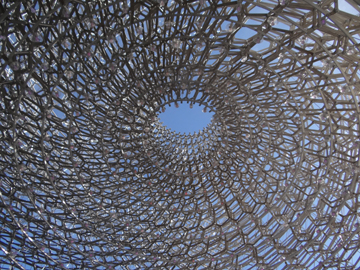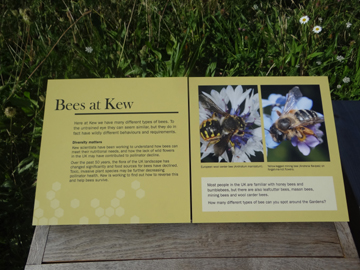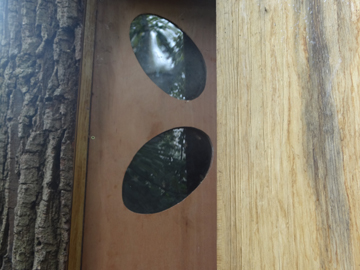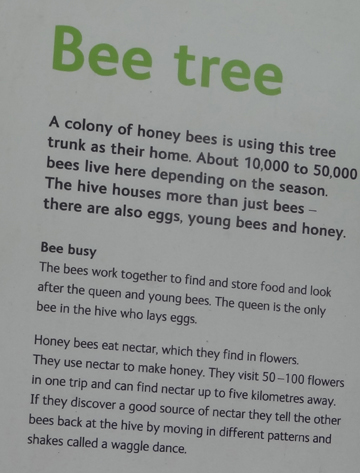Butterflies & Bees
-Usha Nair
'Butterflies, bees, our winged happy friends; Oh ,to dance in the air and float on the breeze'-Terri Guillemets
On 1st October of this year, BBC reported that Hawaiian bees are listed first on the U.S. Endangered Species list. Skipping to the other side of the globe, another report that caught my eye stated that in India, flowering plants and their pollinators
are declining in the Himalayan region, one of the 34 official Global Biodiversity hotspots. The apple orchards of Kullu Valley, a major agriculture centre in this hotspot, is impacted by climate change and consequent decline in plant biodiversity, resulting
in reduced numbers of bees and butterflies.
Many of us can vouch for the fact that fifty years ago, bees & butterflies, other insects and animals, just naturally did their jobs. Plants were pollinated and the fields would yield crops, vegetables and fruit. Today, our fields are much larger and
the use of pesticides has adversely affected pollinators. Decline in the health and population of pollinators pose what could be a significant threat to the integrity of biodiversity, to global food webs, financial stability of agricultural regions, and to
human health. According to Wikipedia, at least 80% of our world's crop species require pollination to set seed. An estimated one out of every three bites of food comes to us through the work of pollinators.

The entire ecosystem depends upon pollination. Pollination is the process of pollen being transferred from the male part of a flower called an anther, to the female part of a flower called a stigma. Pollination is essential to the survival of plants because
it is part of their reproductive process. It is equally important for people, because without pollination we would not have vegetables and fruits to eat. Animals, birds, and insects that carry the pollen between flowers are called pollinators. Insect pollinators
include bees, (honey bees, solitary species, bumblebees);pollen wasps ; ants; a variety of flies including bee flies, hoverflies, butterflies and moths; and flower beetles.

The most well known pollinators are bees. They have specialized structures on their bodies that collect pollen and through flight they carry the pollen to the next plant. Most bees gather nectar, a concentrated energy source, and pollen, which is high
protein food, to nurture their young, and transfer some among the flowers as they are working. The bee collects the pollen by rubbing against the anthers. The pollen collects on the hind legs, in a structure referred to as a "pollen basket". As the bee flies
from flower to flower, some of the pollen grains are transferred onto the stigma of other flowers.
The second most productive pollinators are butterflies. Butterflies typically visit brightly- coloured (red, yellow, orange) flowers in clusters, which provide ample nectar during the day when they are open and provide landing platforms. Although butterflies
visit flowers often, they are not as effective pollinators as bees.

According to Regina Cutter Edwards , for farmers to get good crop yields in current times, they must 'manage' pollination. It is not uncommon for growers to ship in large numbers of bee hives during blooming season to get their fields pollinated. Although
managed bee hives are increasing worldwide, these cannot compensate for the loss of wild pollinators in many locations. Pollinators provide a key ecosystem service vital to the maintenance of both wild and agricultural plant communities. In 1999, the Convention
on Biological Diversity issued the São Paulo Declaration on Pollinators, recognizing the critical role that these species play. Today pollinators are considered to be in a state of decline and some are in danger of extinction. In May 2015, the U.S. Obama Administration
released the 'National Strategy to Promote the Health of Honey Bees and Other Pollinators'. The goal is "tackling and reducing the impact of multiple stressors on pollinator health, including pests and pathogens, reduced habitat, lack of nutritional resources,
and exposure to pesticides."

Plants fall into 'pollination syndromes' Different types of pollinators are attracted by different types of plants depending upon the overall flower size, the depth and width of the corolla, the colour, scent amount of nectar, composition of nectar, etc.
When these characteristics are experimentally modified (altering colour, size, orientation), pollinator visitation are affected/ decline.

The role of pollinators is largely unknown in the urban world. My mind flashed back to the sight of hundreds of bees lying dead on the pathways of a residential complex, as panic-stricken residents smoked out beehives in order to get rid of attacking bees.
Little thought was ever given to the purpose of these bees-they were pests and needed to be removed!! The thought begged another question-how many of the current generation of children, growing up in metro/urban cities have ever seen or run after butterflies?
Butterflies are nowhere to be seen in any urban settlement, as manicured lawns and 'engineered' non-fragrant flowers no longer provide a habitat for the breeding of these flitting, multi-coloured, exquisite pollinators, which have inspired poets, artists
and others over countless generations and have been the delight of bewitched children all over the world. "Where have those flowers and butterflies all gone?" lamented the famous American poet, Robert Frost. His words continue to blow in the wind!! It is
evident that serious focused efforts need to be taken world-wide, to nurture and restore the pollinator population to a sustainable level that will support global bio-diversity and food security.
(Usha Nair is a nature lover who can be contacted at ushaenvironment@gmail.com)
Photographs -Susan Sharma